This week, gentle readers, my pedagogical instincts got the better of me, and I am taking you on a diversion from the usual perils and complexities of Brexit into the arcane world of the EU budget process.
And one particularly obscure but important and under-reported aspect of it.
By the end of 2018, Annemie Turtelboom – a member of the European Court of Auditors – explained, the outstanding liabilities of the European Union amounted to an extraordinary €281 billion.
That’s the gap between the commitments or promised payments made by the union in all its programmes, and the amount actually paid out so far.
It’s what the EU owes, known here as the reste a liquider (RAL).
It’s the equivalent of nearly twice the annual EU budget of €145 billion, or roughly two per cent of everything the EU produces in a year.
And its getting bigger. Fast.
It doubled from €138.7 billion at the end of 2007 to €281 billion at the end of 2018, and is expected to continue to rise in the future. Up to €314 billion by the end of 2023, according to consistently understated estimates by the European Commission.
In 2010, a fifth of the EU's commitments were outstanding – now, a quarter. And in the time since then member states have on average increased by six months, to 2.7 years, the lag between securing a funding commitment for projects and, after getting them off the ground, securing payment for them.

Kicking the can
The EU Court of Auditors is worried.
Turtelboom, the Belgian member of the court, predicted at media a briefing in Brussels this week that the RAL will be significantly higher than the commission’s forecasts, and warns that failure to take the issue seriously could soon jeopardise the ability of the EU to fund its programmes.
In 2013-15, with cash going out faster than it was coming in because of past commitments needing to be funded, the EU in effect ran out of money and several programmes had their funding put back, with member states having to stump up the shortfall temporarily.
Delays in taking up allocated cash can lead to it being withheld by the commission
Although the budget, which legally must balance each year, got back in kilter the next year, Turtelboom warns that problems could escalate in the next seven-year budget, the 2021-27 Multiannual Financial Framework (MFF), which is currently being negotiated by the member states.
There is what she describes as a “snowball effect” – commitments and payments from different MFFs overlap. In the early years of an MFF, many payments relate to the commitments of the previous MFF and even to that before it.
This overlap ensures that the total RAL can not decrease, as by the time the commitments of an MFF start to be paid, the commitments of the next start to be created.
And when, as the commission did recently, it allows member states more time to take up their payments, the overlap simply gets worse and the can is kicked further down the road.
The court warns that any further delay in agreement of the new MFF – now certain not to be approved before the European elections and appointment of a new commission – will build up more problems and payment deferrals.
Brexit hole
The main challenge lies in the area of structural fund payments, which represent 70 per cent of the RAL (farm payments tend to be settled in the same year they are committed).
There are also considerable differences between member states in terms of their ability to plan and use this EU funding, known as absorption rates.
If they implement programmes at a roughly comparable rate, their share of the RAL should be proportionate to their share of total commitment appropriations. However, differences arise because member states absorb funding at different rates. For the 2014-2020 MFF, those with the highest absorption rates to the end of 2017 were Finland, Austria and Ireland, double those with the lowest rates, Italy, Croatia, Malta and Spain.
These are in part due to differing administrative capabilities, but the court warns that the procedures are too complex and also need to be simplified.
Delays in taking up allocated cash can lead to it being withheld by the commission, although “decommitments” represent only some two per cent of payments.
In the case of Romania, however, exceptionally, a total of of €1.64 billion was decommitted in the the 2007-2013 period, over a third of all EU-wide decommitments.
But the central problem for the EU is that as the RAL soars inexorably, both meeting delayed previous commitments and making new ones will become increasingly difficult.
The hole in the budget that Brexit is likely to represent will only make matters worse.














